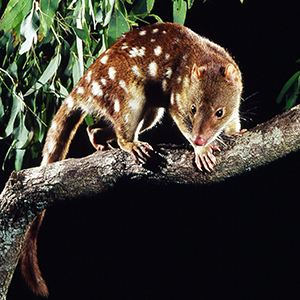
Evidence of the endangered spotted-tail quoll in the City of Logan has been confirmed for the first time in more than a decade.
Specially trained detection dogs have led the research funded by Logan City Council's Environmental Levy.
The native spotted-tailed quoll (Dasyurus maculatus maculatus) is a carnivorous marsupial listed as 'vulnerable' under Queensland's Nature Conservation Act and 'endangered' under the Federal Environment Protection and Biodiversity Conservation Act.
The last known sighting in Logan was in 2005 but some rural parts of the city have been historically known as quoll habitat.
Council partnered with Wildlife Preservation Society Queensland (WPSQ), the Quoll Seekers Network, Carnarvon Canines and University of Sunshine Coast to establish the existence of quolls in Logan.
The dogs, trained in the detection of specific odours, were used to determine the presence of quoll in likely dens and evidence of their scat (faeces) in nearby bushland.
Eight sites across Logan were selected as having potential habitat critical to quolls' foraging movement and denning preferences.
Quoll hide in caves, rock crevices, logs and tree hollows.
They are mostly nocturnal and can roam up to six kilometres from their den looking for food. They use faeces to mark their territory.
Three private properties at Undullah and Lyons were surveyed in 2019 and again this year with a property at Lyons returning a positive determination of quoll scat and odour.
However no quolls were spotted either during surveys or on wildlife monitoring cameras. It is also difficult to determine how old the scat and odour may have been.
Sites at Wolffdene and Park Ridge South returned no strong evidence of quolls during surveys undertaken in last year.
City Planning, Economic Development and Environment Chair Councillor Jon Raven said the detection of quoll was another example of Council and the community working together to protect our environment.
"Last year we used DNA to confirm the presence of platypus in the Albert River," Cr Raven said.
"Now these very talented dogs have assisted our wildlife experts to find strong indicators that spotted-tail quoll may still be existing in Logan.
"This is amazing news and demonstrates the great work Council and the community are doing to help protect and improve our wildlife, not just for quolls, but all our native species."
WPSQ Projects Manager Matt Cecil said two detection dog handlers participated in the research over the past year.
They were Carnarvon Canine's Amanda Hancock with dogs Sparky and Lily and the University of Sunshine Coast's Russell Miller and his dog Baxter.
"Logan City Council has been on board with the project from the start," Mr Cecil said.
"They have helped with funding opportunities and land access and trying to get spotted-tail quoll conservation into the minds of the Logan community."
Community engagement will now be done to increase awareness of the quoll's existence and provide tips on how landowners can aid in the conservation of this threatened species.
Council's 2020/2021 Budget, announced last week, included $9.9 million for initiatives to enhance the natural environment in Logan, many funded through the Environmental Levy.
Watch our video at: youtube.com/watch?v=ejn5s9DAIg8






